Modern rock garden ideas: 17 contemporary looks for rockeries
These modern rock garden ideas are low maintenance, drought tolerant and perfect for adding interest to spaces big and small
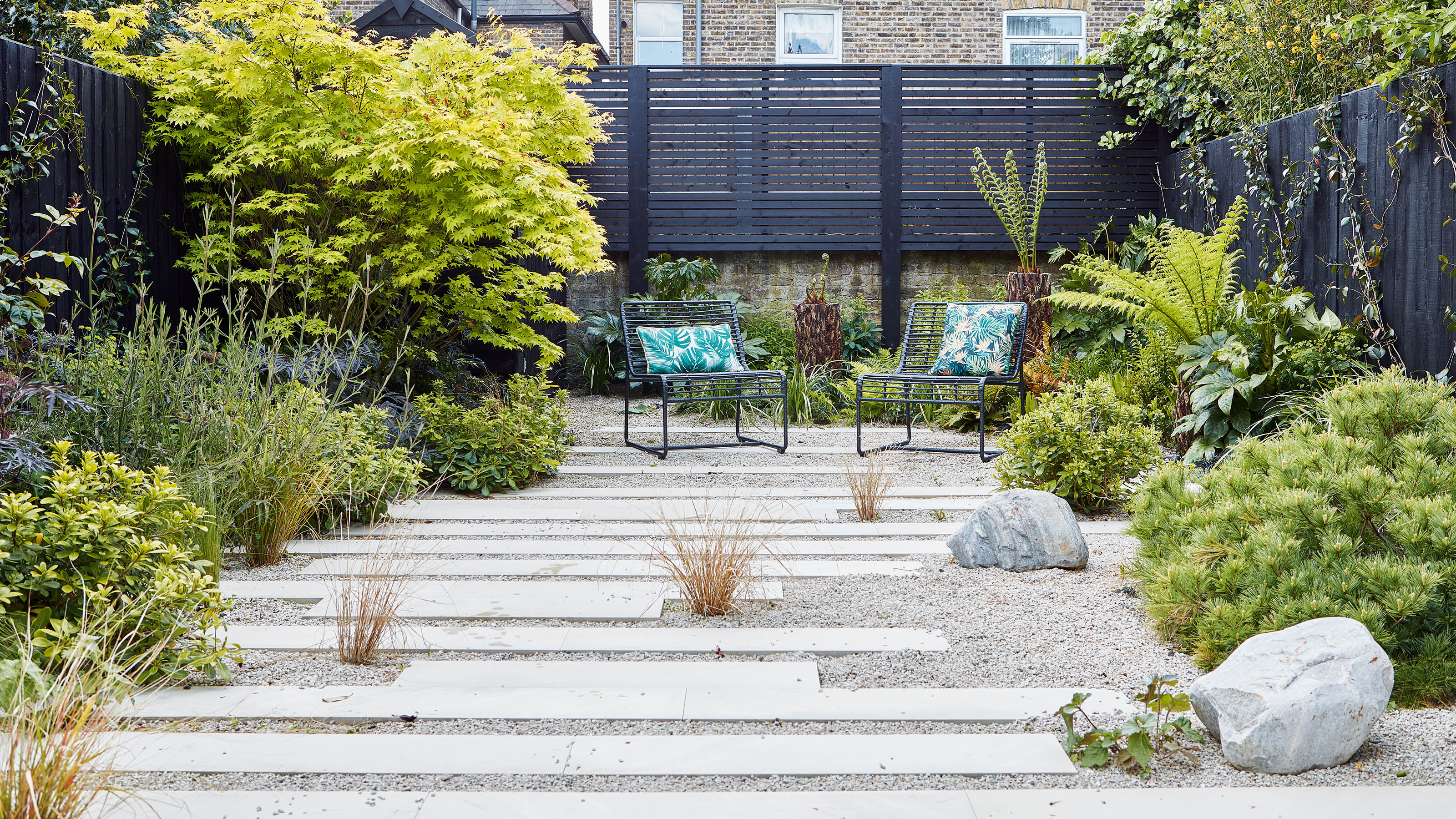

As we are all leading busier lifestyles, modern rock garden ideas tick the low maintenance gardening box in a big way. The ease of rock gardens can largely be put down to their natural drought-tolerance. Tough evergreen grasses, small alpines and perennials will slot beautifully into crevices and thrive with minimal watering.
Ultra modern gardens don’t necessarily even need established plants. You can create different areas of interest just using rocks of different sizes and heights, and containers can bring pops of planting interest.
The rock garden revival has given rise to a plethora of modern garden ideas which are a far cry from the rockeries of the Victorian era. Running water or a small pool and discreet lighting are often a feature.
Rather than struggling to improve the soil quality of a gravelly patch, consider that this might be the ideal area for a rock garden in your plot. 'Rock gardens can add height and interest to a garden and enable you to grow a group of floriferous plants that may struggle for survival elsewhere in your garden,' says award winning garden designer Kristina Clode
'It can be a great way to use rocky material if you are lucky to have it on site, or use up spare uncontaminated hardcore, rubble and soil in the base layers of your mound,' she adds.
Be part of the rock garden revival with these modern rock garden ideas
'Well made rock gardens are beautiful, natural looking and brimming with colorful alpine plants which are low maintenance and drought tolerant,' says Kristina Clode.
The aim for your modern rock garden ideas is to create a sharply drained, sunny growing environment which emulates high altitude rocky alpine slopes where the light levels are high and the winters cold and dry. Our edit of contemporary looks is sure to get you inspired.
1. Use gravel to blur the boundaries
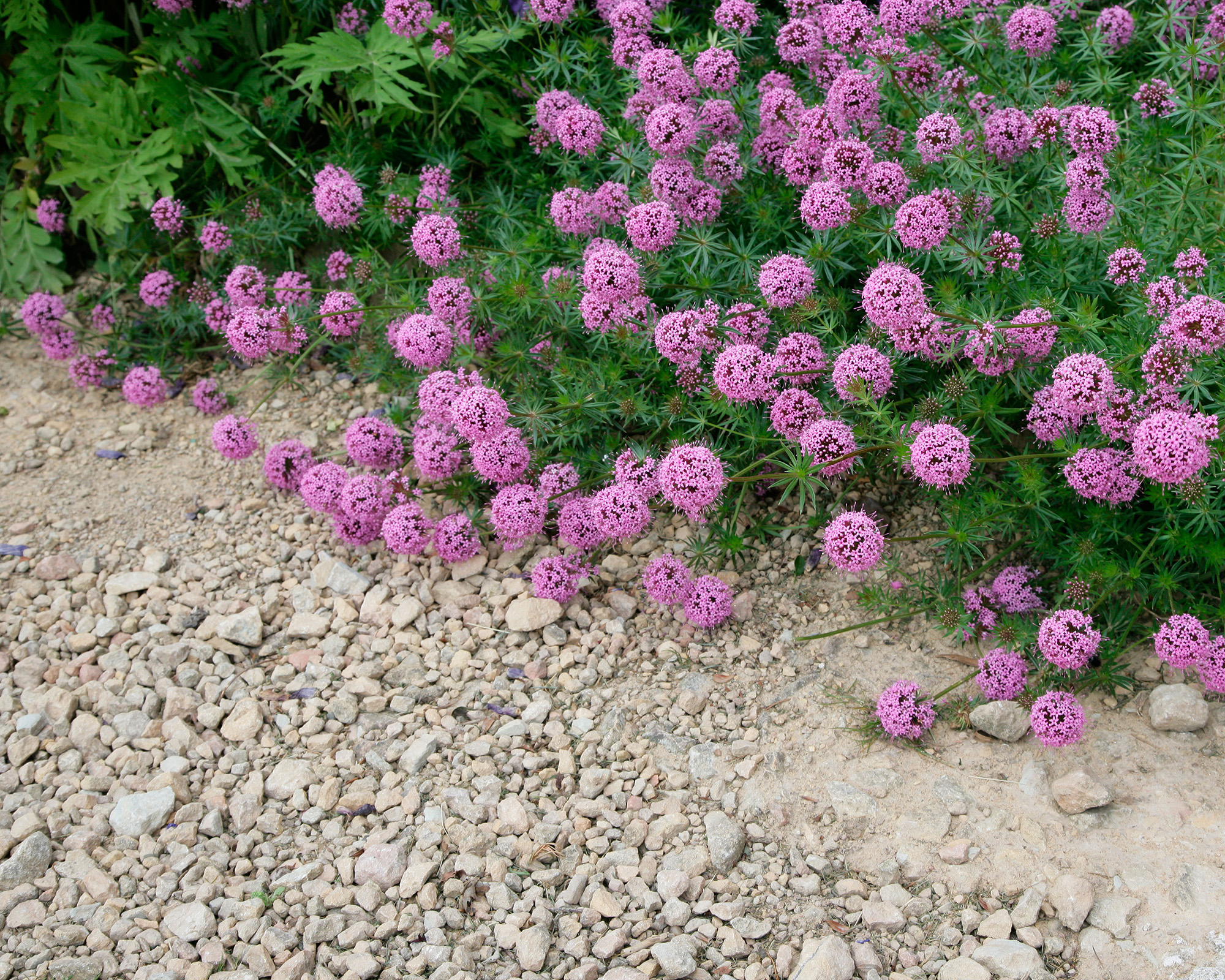
Phuopsis stylosa flowers pop against this light colored aggregate in a rock garden
If you're incorporating garden gravel ideas in your rock garden, try to use landscaping materials that are similar in color to avoid an incoherent look. One way to ensure that materials you are using look at home in your garden is to shop local. 'Use local rock, it will fit in better to the local surroundings, look more realistic and is better for your carbon footprint,' advises Kristina Clode.
'This will also mean that the materials feel inherently at one with the surroundings and this is key for any rock garden, large or small. Use local stone and gravel and the garden will feel at home.'
The way to use gravel as a modern paving idea in your rock garden is to mulch any bare soil around your plants. 'This will help to cut down on weeds and water loss,' advises Angela Slater, gardening expert at Hayes Garden World.
2. Create terracing with metal edging
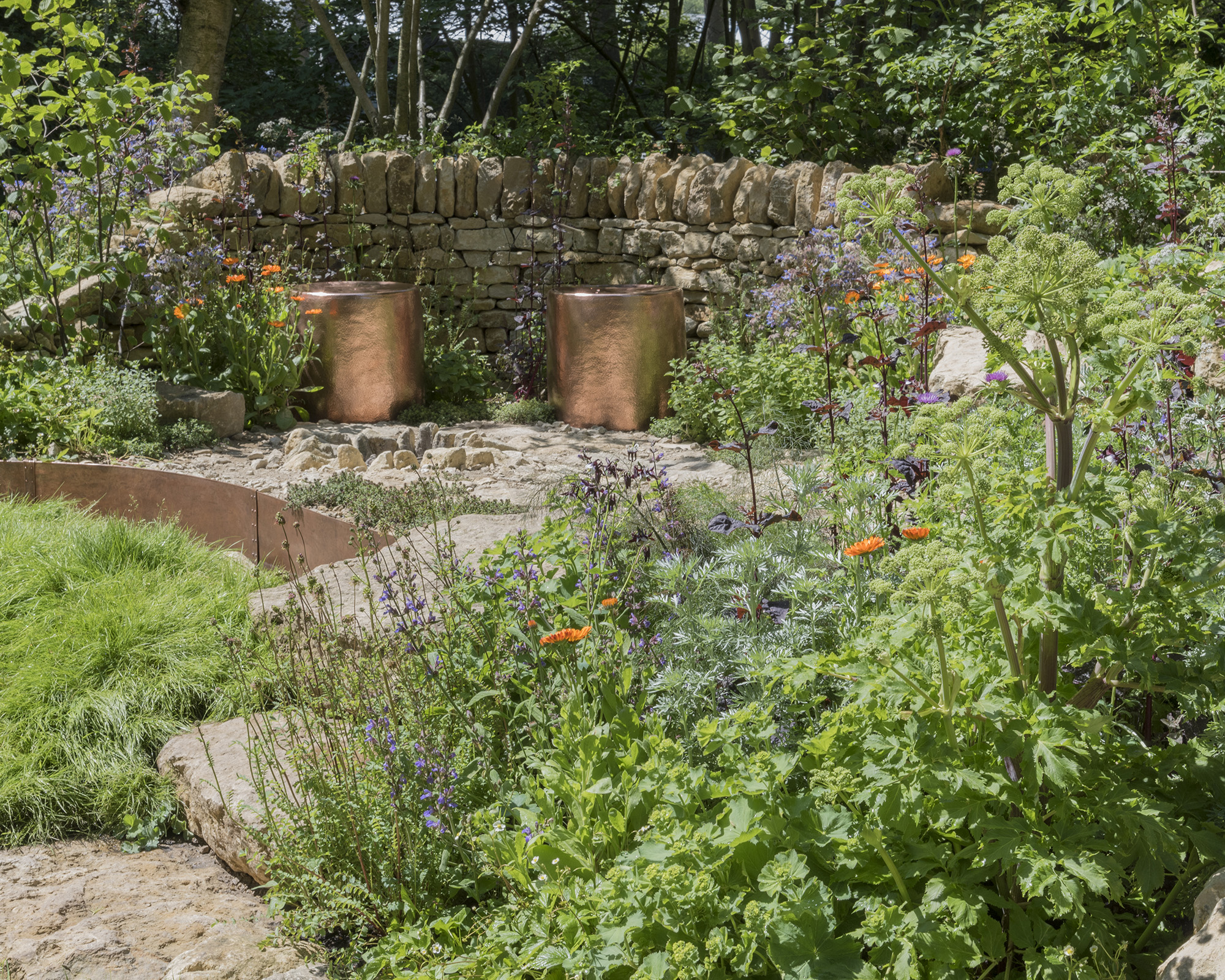
The Warner Edwards Garden, designed by Kate Savill and Tamara Bridge at the RHS Chelsea Flower Show 2019
If you have a sloping site then this is by no means an impediment for a rock garden. On the contrary, plants which are suited to rock gardens will require good drainage and raised levels will automatically improve this.
If you want to create some modern rock garden ideas in a sloping garden, a good way to achieve this is by using terracing. Planting on different levels is a great technique for creating interest in both small gardens and bigger spaces, and this is because the eye is drawn to different levels.
To recreate this look, build gravel-filled, stepped beds. Using sheets of reclaimed metal to keep the terraced levels in place is a great option for how to make a garden feel modern.
Fill these stepped beds with alpine and perennial plants or combine classic alpines with succulents such as sedum and echeveria. The shape can be designed to fit your garden layout and the material chosen to suit its style.
3. Cut shapes into a plain patio
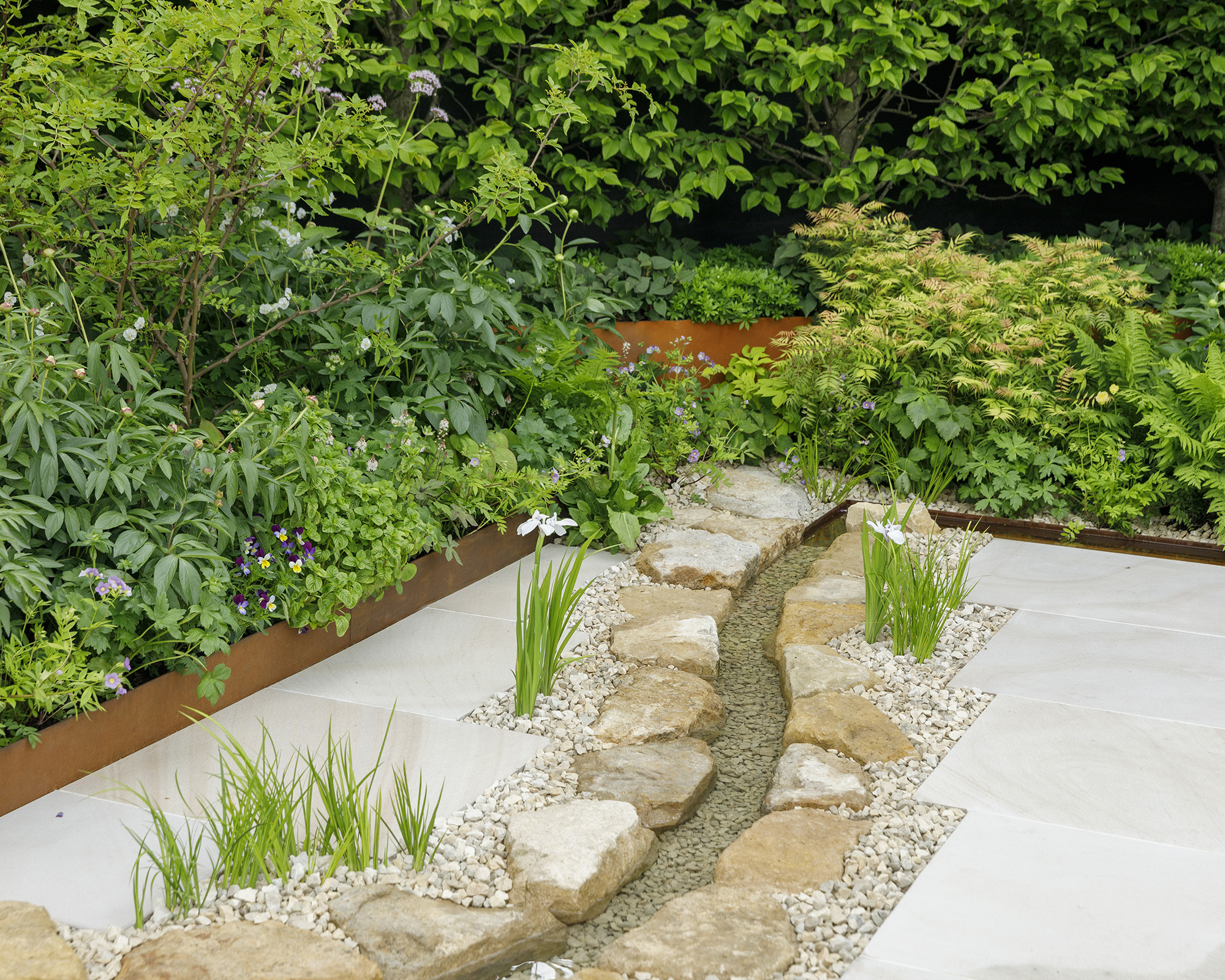
'Kampo no Niwa' - the modern rock garden designed by Kazuto Kashiwakura and Miki Santo for the RHS Chelsea Flower Show 2019
Why not bring some rock garden elements into your existing patio ideas for an ultra serene setting? Take this design by Kazuto Kashiwakura and Miki Santo from the RHS Chelsea Flower Show 2019. It is inspired by the designer's island home in the north of Japan, Hokkaido. It's known for its rugged landscape of mountains and volcanos.
'The rill with rocks in our 'Kampo no Niwa’ tried to bring beauty of nature and flux of time into the garden,' Kazuto told us. 'The sound of moving water is very beautiful and brings with it feelings of joy and happiness. The stream flowing from the stone wall and through the rocks represents the mineral rich snow melt water bringing nutrients from the mountain. Pond water seeps down through the soil releasing these minerals and nourishing the plants. People harvest these plants and herbs for the beneficial minerals and nutrients nature provides.'
Light-colored rocks and gravel have been used as modern edging ideas for the metal water rill which runs through the seating area. It has the effect of softening the look of the patio and giving it a naturalistic element which is extremely calming and tranquil.
4. Add drama to a seating area
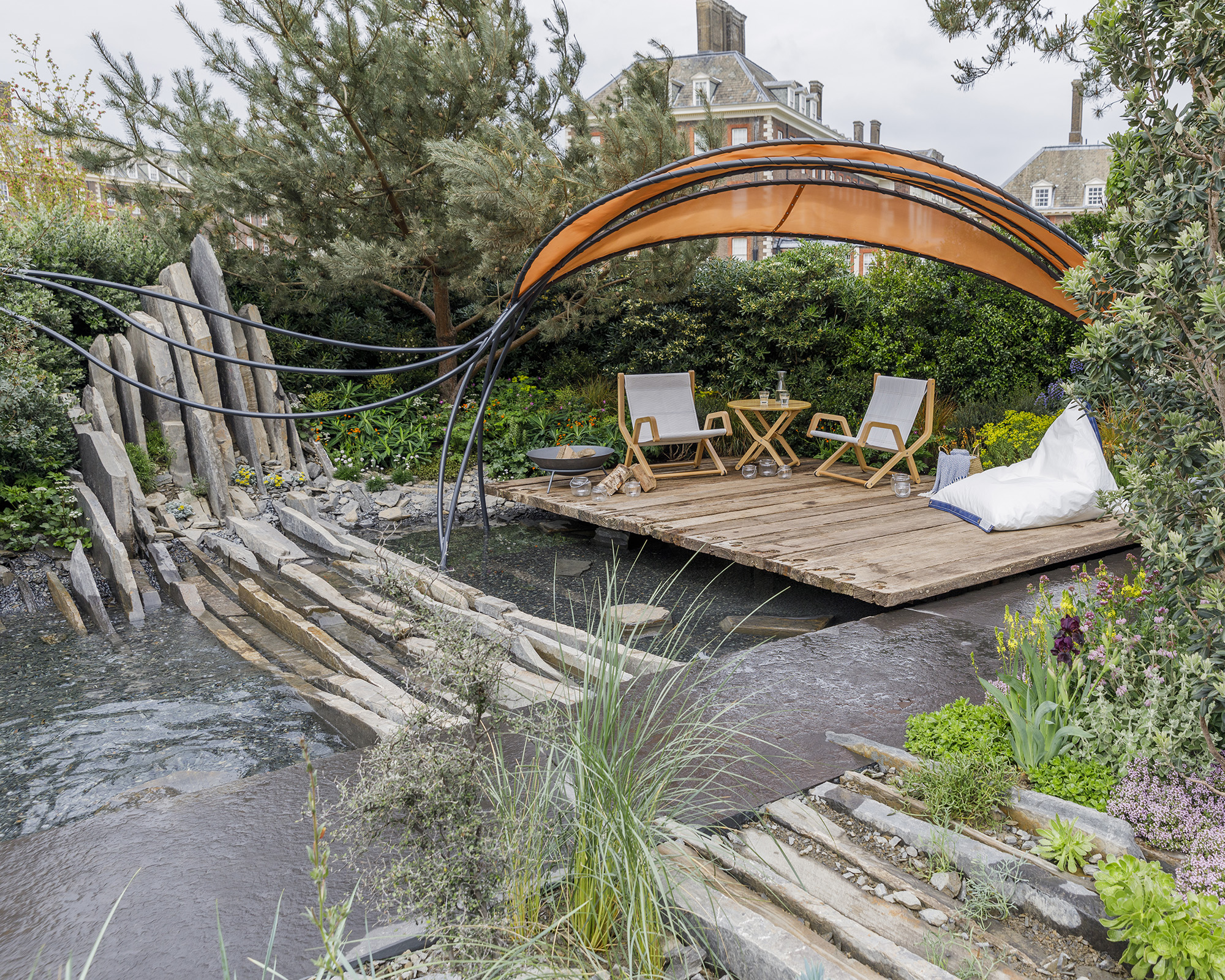
Beyond The Screen garden from the RHS Chelsea Flower Show 2019 by Joe Perkins
'On a smaller scale crevice gardens can be very effective,' says Kristina Clode. 'They use thinner flat pieces of stone buried close together vertically "on edge", with only the very tops of the stone showing.'
A great example of this landscaping idea with rocks is Joe Perkins' RHS Chelsea gold medal winning design from 2019, pictured. Free-draining gritty soil is put in the crevices between the stones and the roots of the plants grow deep into the crevices as they would on a rocky cliff edge, which makes them extra drought tolerant and resilient.
'When building a rock or crevice garden it is essential to observe how natural rock formations are formed and to try and recreate that look yourself,' explains Kristina. 'Look at the layering or strata that makes up the individual rocks and how the strata lines align with those of their neighbors, usually horizontally, and place your own stones in the same way.
'A range of sizes and thicknesses of stone should be used, with the edges linearly aligned to create the look of natural seams of rock, with gravel or a complementary aggregate brushed around the plants in the crevices between.'
5. Add serenity with a rock pool
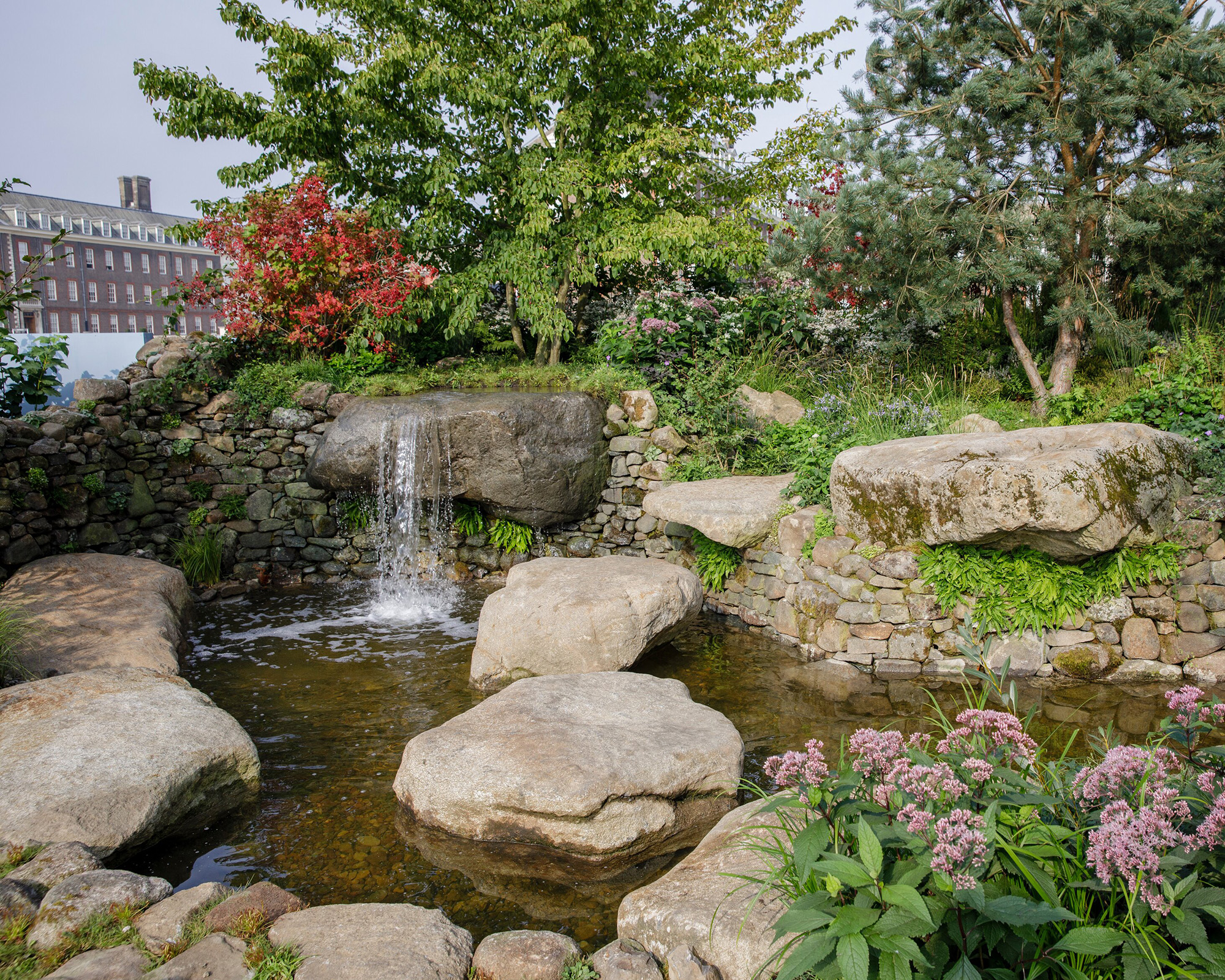
The Psalm 23 garden at Chelsea Flower Show 2021, designed by Sarah Eberle
If space allows for it, you might want to consider incorporating a natural rock pool or garden pond idea into your rock garden design.
A great example of how rocks and water go together is the Psalm 23 garden at Chelsea Flower Show 2021, designed by Sarah Eberle. It incorporates a cascading waterfall and natural looking pool and was inspired by the natural landscape of Dartmoor.
This is a great take-home piece of advice for when you're thinking of your own modern rock garden ideas – look to your own favorite natural landscapes for inspiration.
6. Go for a minimalist look
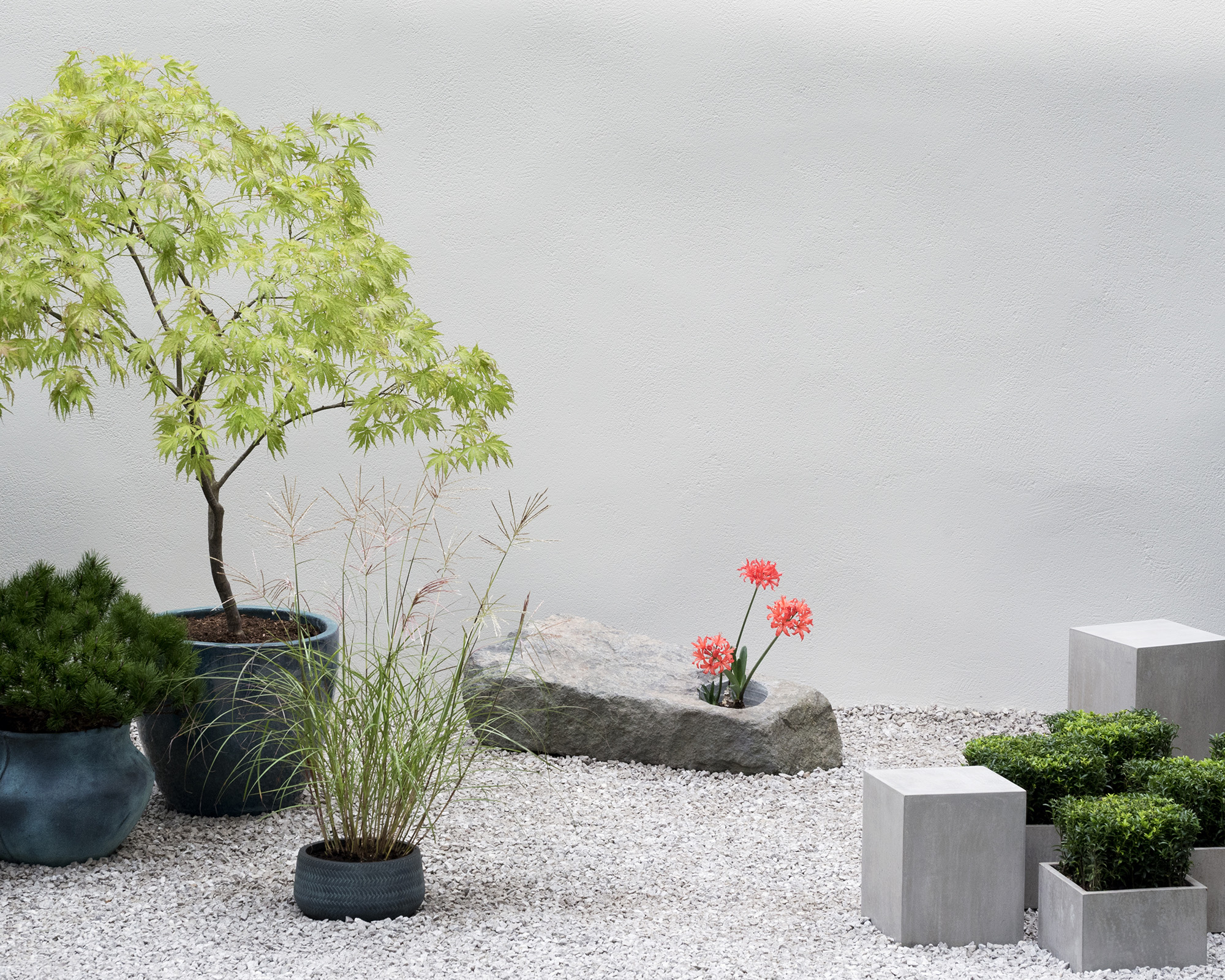
This contemporary rock garden was designed by Mika Misawa at the 2021 RHS Chelsea Flower Show
This container garden designed by Mika Misawa at the 2021 RHS Chelsea Flower Show demonstrates how rocks can be used in a small, contemporary setting.
The area of this space is just 10x13ft and Mika has used fragments of nature to create a minimalist, contemporary space which makes you feel connected to wider nature.
This design shows how important it is not to cram too much into your small rock garden ideas. In her scheme, Mika applied the Japanese garden idea of 'Ma' which is about considering the negative space or 'space in between'. In other words, the gaps in your space are just as important as the areas which have been filled.
So when designing your modern rock garden ideas in a small space, try to leave areas free and uncluttered for a truly minimalist look.
7. Add to existing stone steps and walls
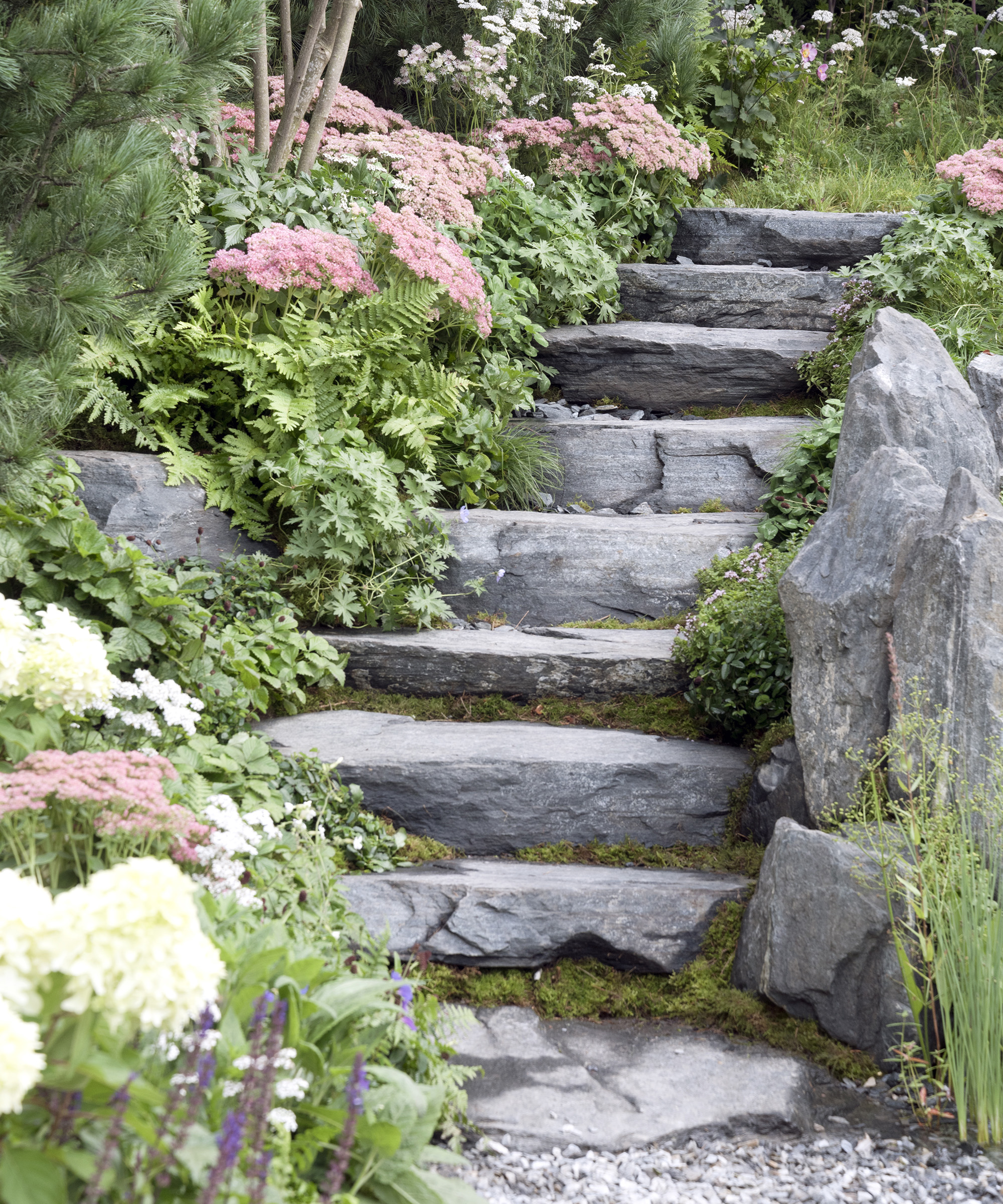
Rock garden designed by Katerina Zasuckhina and Carly Kershaw at the RHS Chelsea Flower Show 2021
Garden steps and walls are ideal for cultivating alpines. Alpines (Campanula, Dianthus, Erodium and Saxifraga) will flourish in the well-drained, sun-baked conditions. Many plants, such as Erigeron karvinskianus, will grow in any cracks and crevices – forming hanging waterfalls of flowers.
Although alpines are some of the best drought tolerant plants as they are resilient and grow well in poor soils, they hate being crowded by fast-growing weeds that will steal valuable soil nutrients.
'Getting rid of weeds helps rockery plants, makes the area look tidier and removes places where pests lurk and fungal diseases incubate,' says Amateur Gardening expert Ruth Hayes. 'Keeping a good layer of gravel around alpines boosts drainage, helps the soil retain moisture and lifts low-growing foliage, protecting it from pests and rotting.'
8. Choose appropriate planting
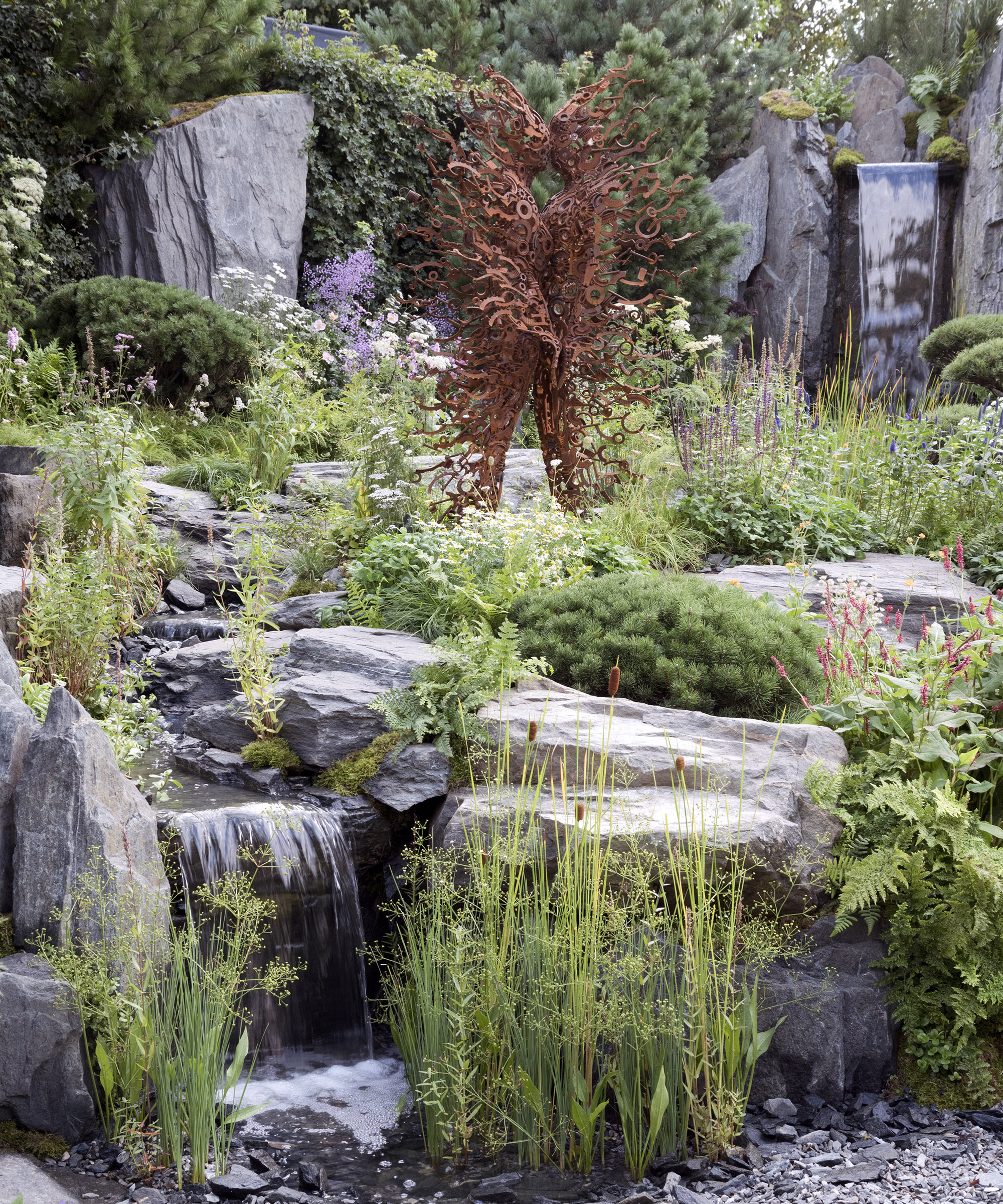
Bodmin Jail - 60˚ East: A Garden Between Continents, designed Katerina Zasukhina and Carly Kershaw
Let nature can be your guide for deciding on appropriate planting for your modern rock garden ideas and you can select plants which are native to mountainous settings where plants spring up between harsh rock formations.
'Break the starkness of the rocks with small trees,' says Kristina Clode. 'Good ones to try include Japanese acers, ornamental rowans and crab apples.'
'A mix of different types of ornamental grass will give movement to the garden as well as being a great option if you're searching for low maintenance garden ideas. The vast majority of the traditional herbaceous border plants would look totally inappropriate in a rock garden as they are too lush and just would not suit the starkness of the rocks.
'Sculptural conifers also suit a rock garden, especially if you opt for cloud pruned specimens or those with attractive gnarled trunks.'
9. Make a mini landscape in a stone container
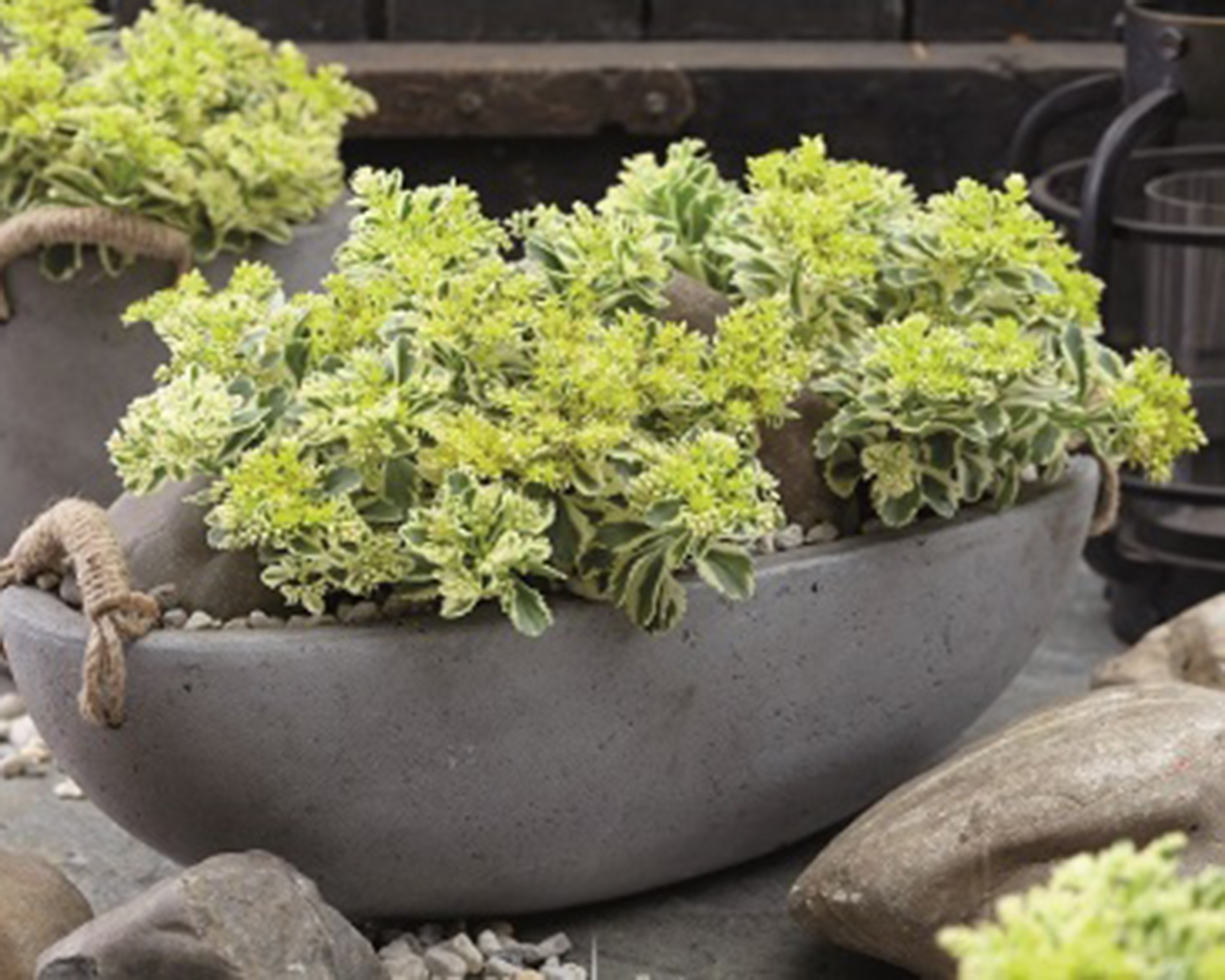
The sedum Atlantis from Suttons won plant of the year at the RHS Chelsea Flower Show in 2019
Beautiful miniature rock gardens can be made into container gardening ideas so you can enjoy a modern rockery aesthetic in a small space.
'The small stature of alpines means that a selection, with a long flowering period, can be grown in a small container,' says Michael Mitchell of Slack Top Alpine Nursery and Garden.
Grow little plants such as thyme, sedum and houseleeks (Sempervivum) in troughs made of terracotta or corten steel. Ensure adequate drainage via drainage holes and the use of gritty compost.
The sedum Atlantis from Suttons won plant of the year at RHS Chelsea Flower Show in 2019. It's drought tolerant making it the perfect in a rock garden or small spaces and it's attractive to bees too.
10. Remodel an existing raised bed
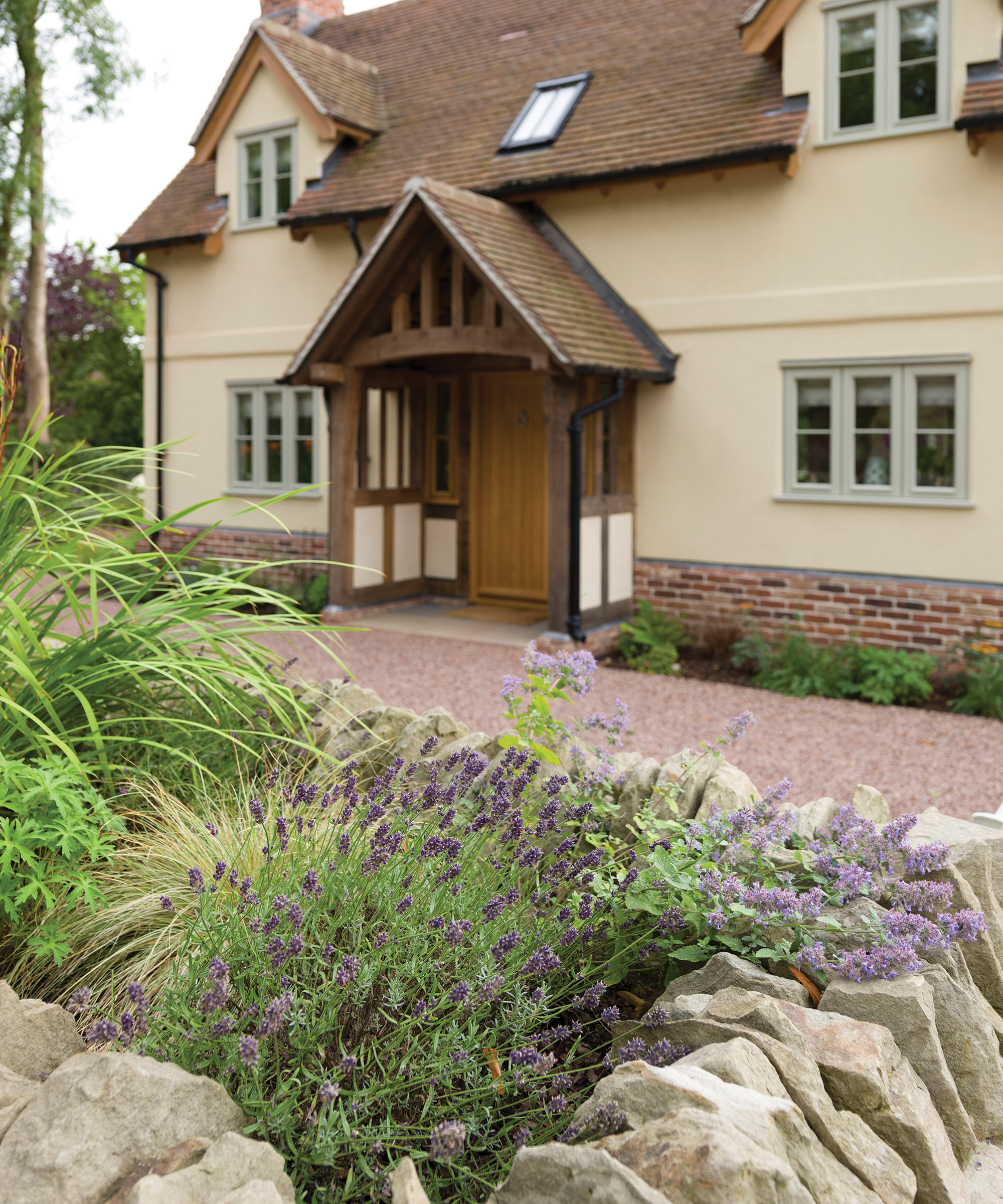
Stone raised beds make a perfect miniature rockery
Try incorporating grasses, perennials and alpines into your existing raised garden beds for an instant rock garden. 'Most of these plants have two simple needs: sun and good drainage, both of which can be provided without the use of any rocks at all,' says Amateur Gardening expert Graham Rice. 'Instead, grow them in raised beds and containers.'
Raised beds which have been constructed using reclaimed stone will fit with a rock garden style. 'The shape can be designed to fit your garden layout and the material chosen to suit its style,' adds Graham.
'Even if you don’t have room for a raised bed, every garden has room for a pot or a trough. Garden planters of various kinds can also be used to grow alpines. Think stone troughs, stone-lookalike troughs made from concrete, old sinks – any large container that has drainage holes and is at least 6in (15cm) deep will work. Pots are ideal, especially terracotta ones.' Fill your raised bed or container with a mix of soil and grit.
11. Bring modern rock garden style to containers
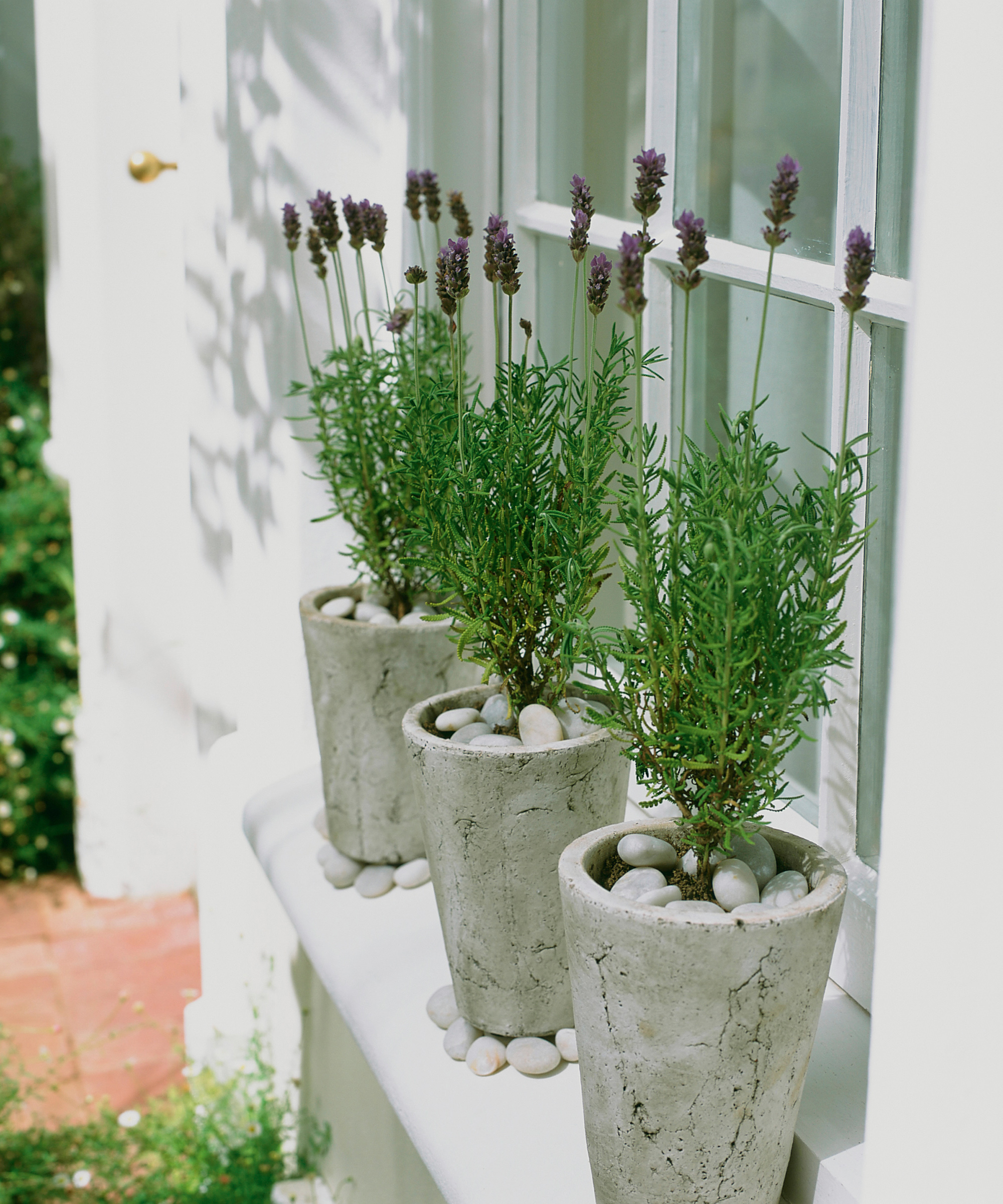
Try a mini modern rockery using stone containers
Many of us won't have space for a rock garden. However if you're fan of this zen-style of garden then why not try and emulate it in a small container display on a windowsill or balcony.
Use stone (or stone effect) pots for a clean and contemporary look. Plant Mediterranean herbs like lavender or alpine plants. Finish by mulching the surface of your soil with pebbles or light colored gravel.
12. Create a sense of journey with a modern path
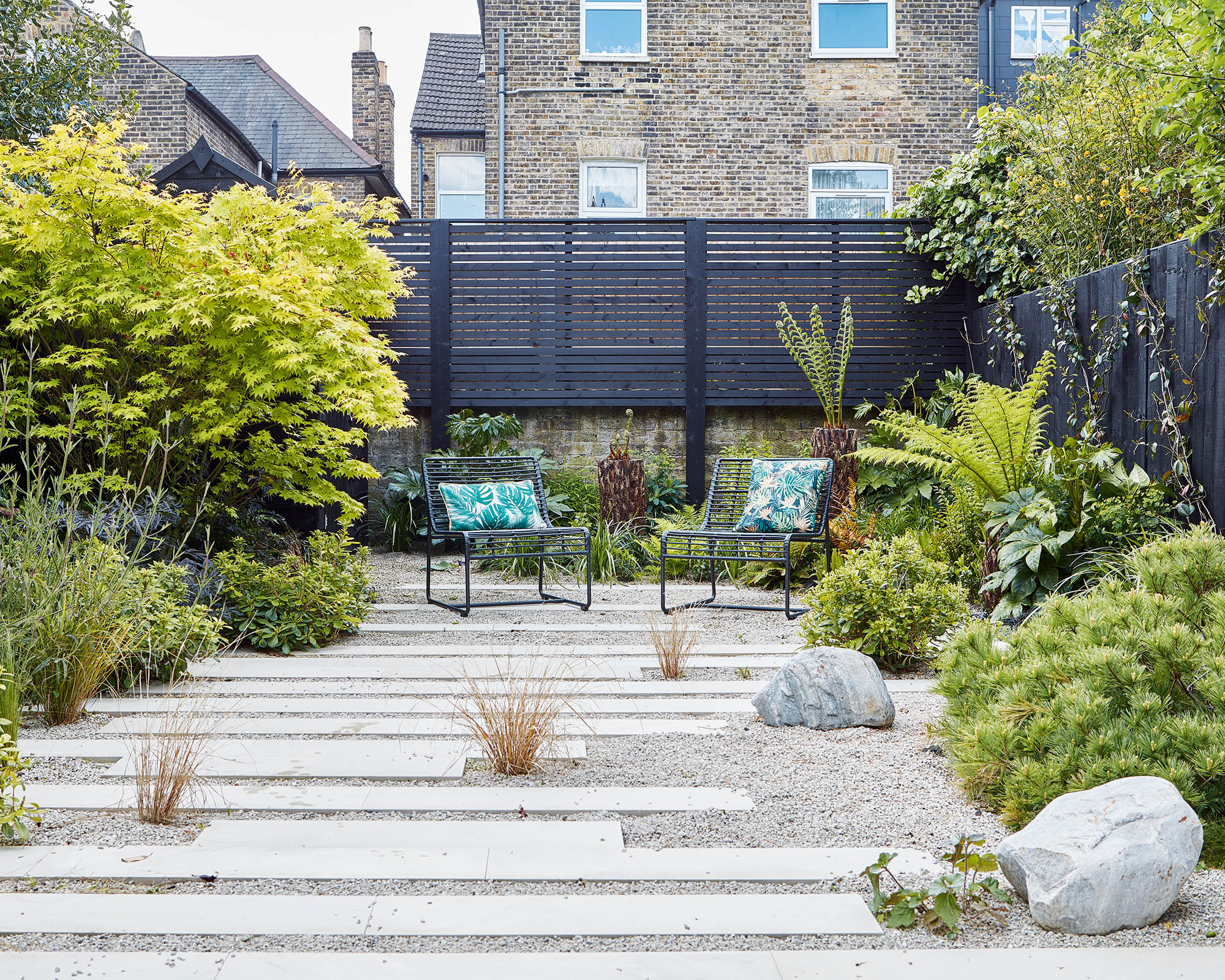
A modern rockery could cover your entire outdoor space
If you're thinking of a rock garden theme which will cover the whole area of your space, think about the other functions you will need for your garden. If you will be entertaining for example, you'll probably want a patio area for seating and the barbecue.
If mobility is an issue, make sure you are considering accessible garden design. Angela Slater, Gardening Expert at Hayes Garden World suggests wide level paths with access for a wheelchair and no protuberances or slippery areas if you have small children. Also consider having somewhere to sit.
'If you have children, consider having an area of shallow water which will attract wildlife but not create a hazard. They will also need a play area where they will be safe and not cause any damage to precious plants.'
13. Take inspiration from Japanese gardens
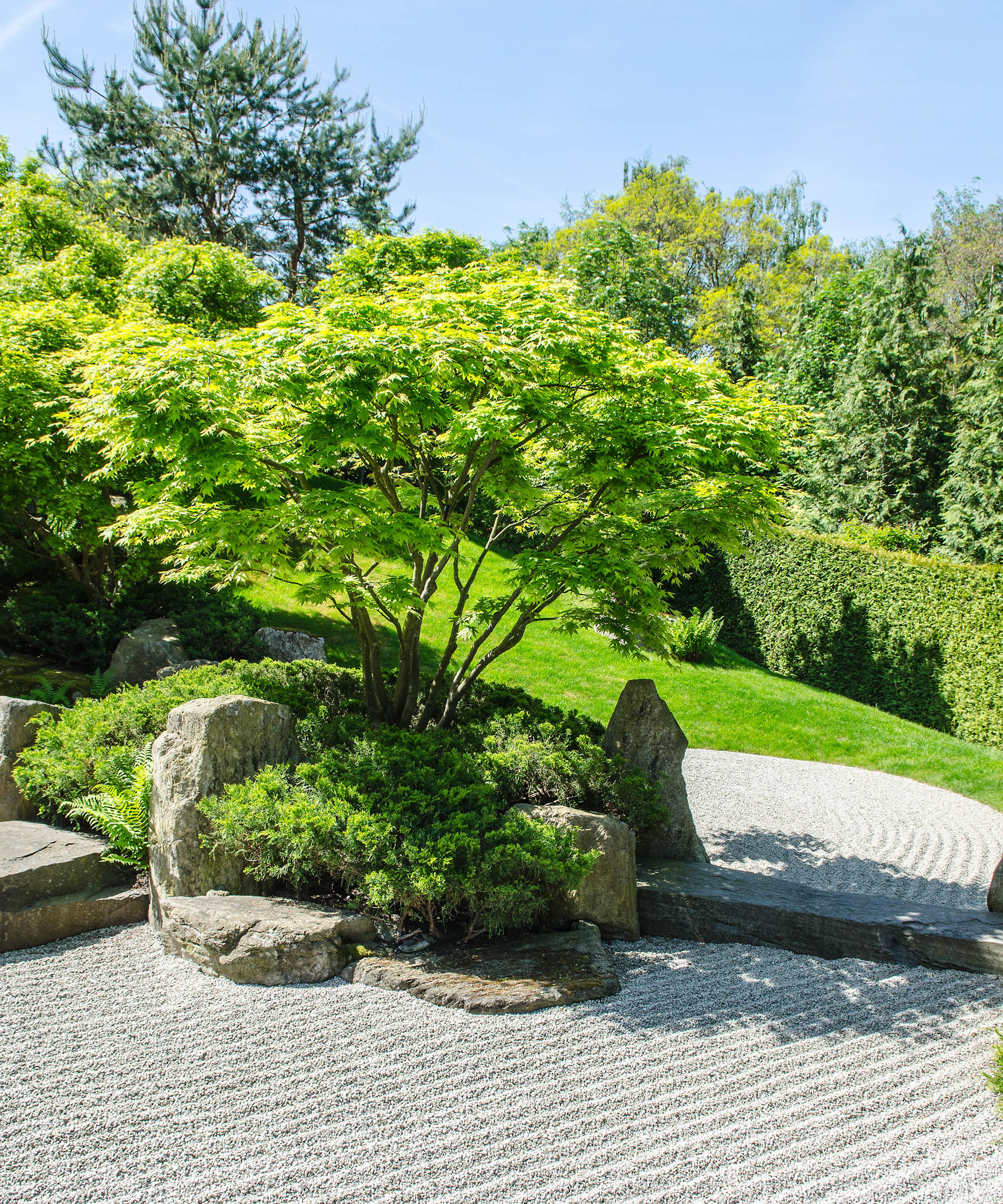
Rocks symbolize mountains in traditional Japanese gardens
'It is thought that the earliest rock gardens were found in Japan in the 8th century, and even today rockeries still dominate garden design in the Far East,' says Amateur Gardening expert Hazel Sillver. 'In the traditional Zen garden (also known as a ‘Japanese rock garden’ or ‘dry landscape garden’), rocks symbolize mountains.
'Gravel or sand is often raked around the rocks to represent valleys or flowing water; sometimes there is no greenery, or it is provided by moss, or by a few plants. The simplicity of these Zen rockeries is designed to facilitate meditation.'
There are plenty of small Japanese garden ideas too, so it's easy to replicate this look on a smaller scale if you don't have a large plot to play with.
14. Use contemporary squares
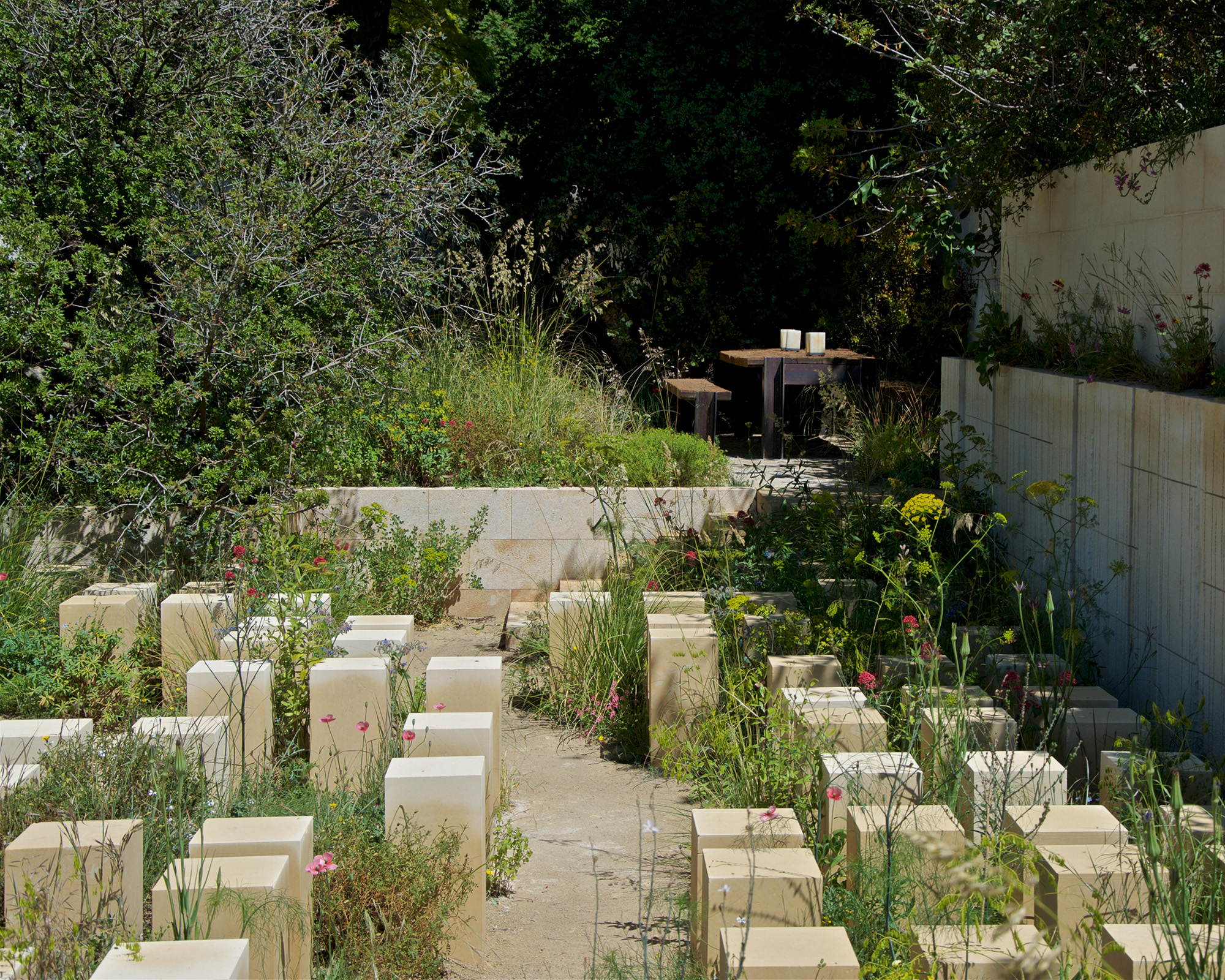
The M&G Garden at RHS Chelsea Flower Show 2017 designed by James Basson
James Basson's 2017 Chelsea Flower Show award-winning garden demonstrated an ultra-modern take on rock gardening. He planted grasses and perennials in between geometric blocks of limestone.
The effect was an uber-contemporary look which is softened by the planting around it. The rocks you choose will almost act as sculptural, artistic elements and therefore thought should be given about how you group them together.
If you are using geometric blocks, you will want to keep these arranged in a more uniform way, rather than scattered about randomly. Whereas if you're going for a natural look it is essential to observe how natural rock formations are formed and to try and recreate that look yourself.
15. Bring in relaxed seating
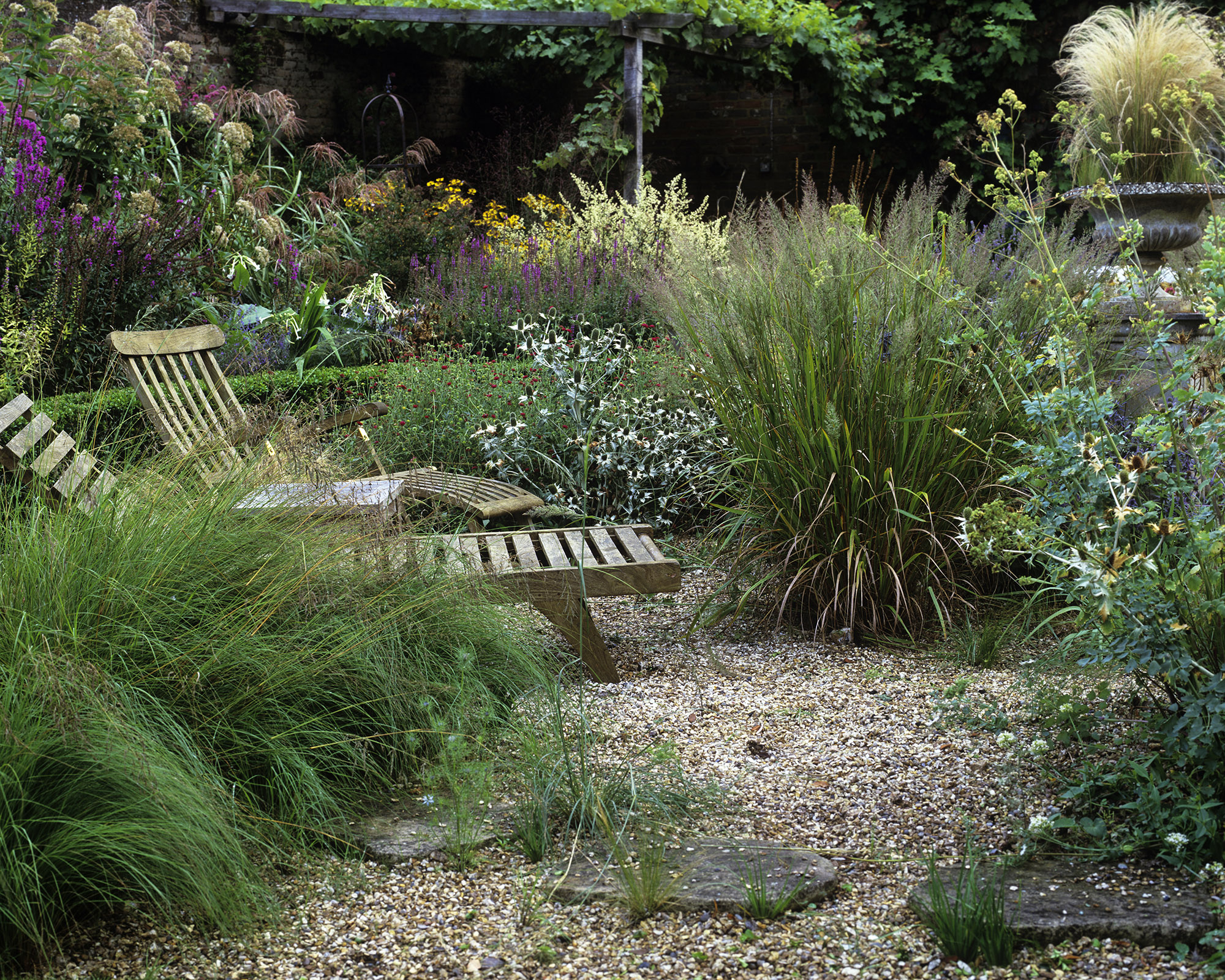
Rock gardens can create a sense of calm and relaxation
Gravel is one of the best patio materials and so if you're using it as part of your modern rock garden ideas then consider leaving space for a serene seating area.
Be sure to have a decent sized area which is completely flat and then add a bistro table or sun loungers for a private area for relaxation.
16. Color match with your home
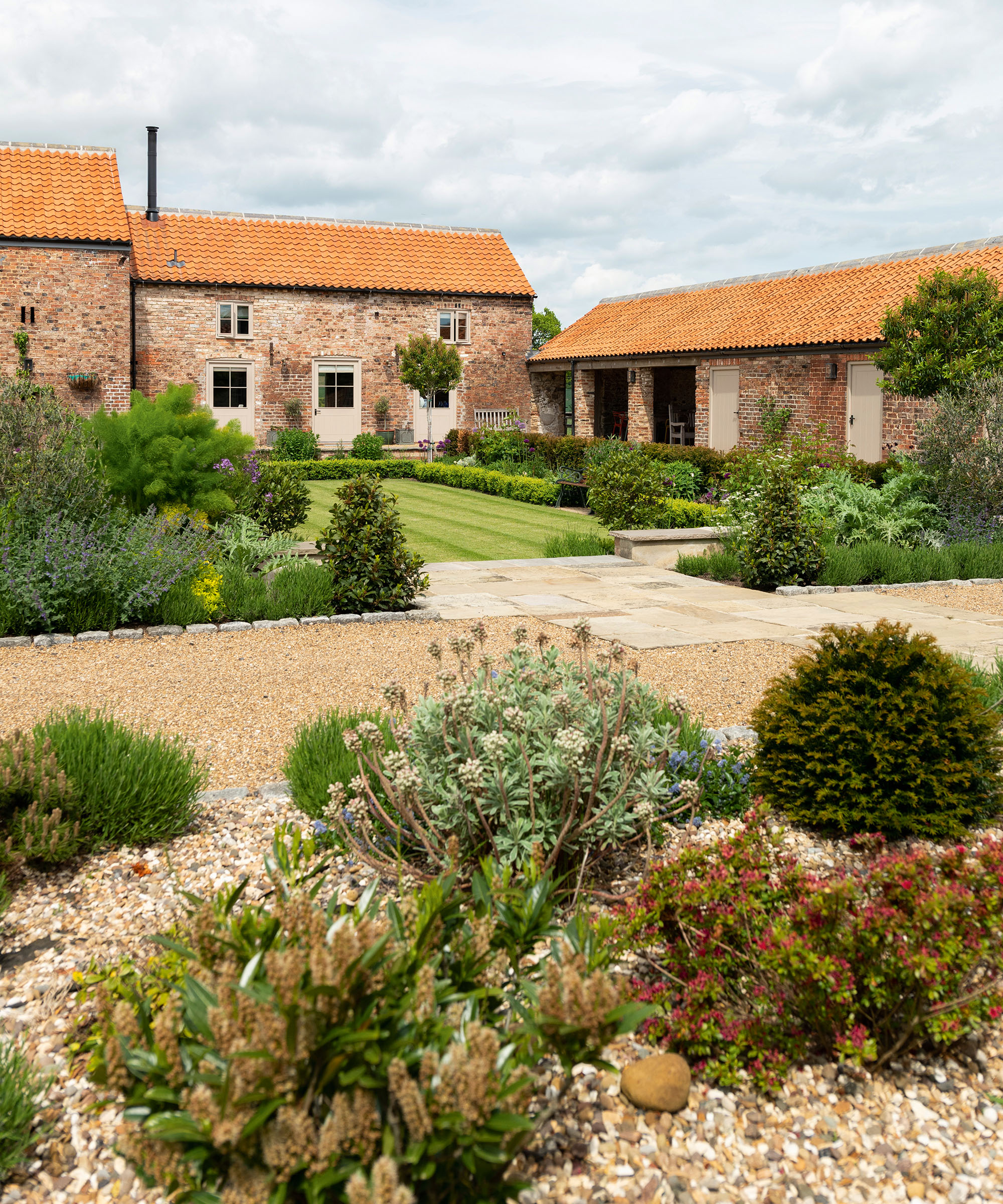
Match materials to their surroundings for a cohesive rock garden design
The key to creating a successful modern rock garden is to make sure that it looks at home in the rest of its surroundings. The way to achieve this is to use gravel and stones which are locally sourced.
As well as creating a cohesive design it's good to know the origins of your materials from an ethical perspective. 'When selecting materials, be aware that some stone has questionable origins – for instance, Indian sandstone might have been quarried by children as young as 10; and strip-mining gravel from the seabed can kill marine life,' says Hazel Sillver.
'Where possible, buy recycled aggregates and stone from salvage yards; or, if purchasing new stone, ensure it has come via an Ethical Trading Initiative company.'
17. Use a big range of sizes
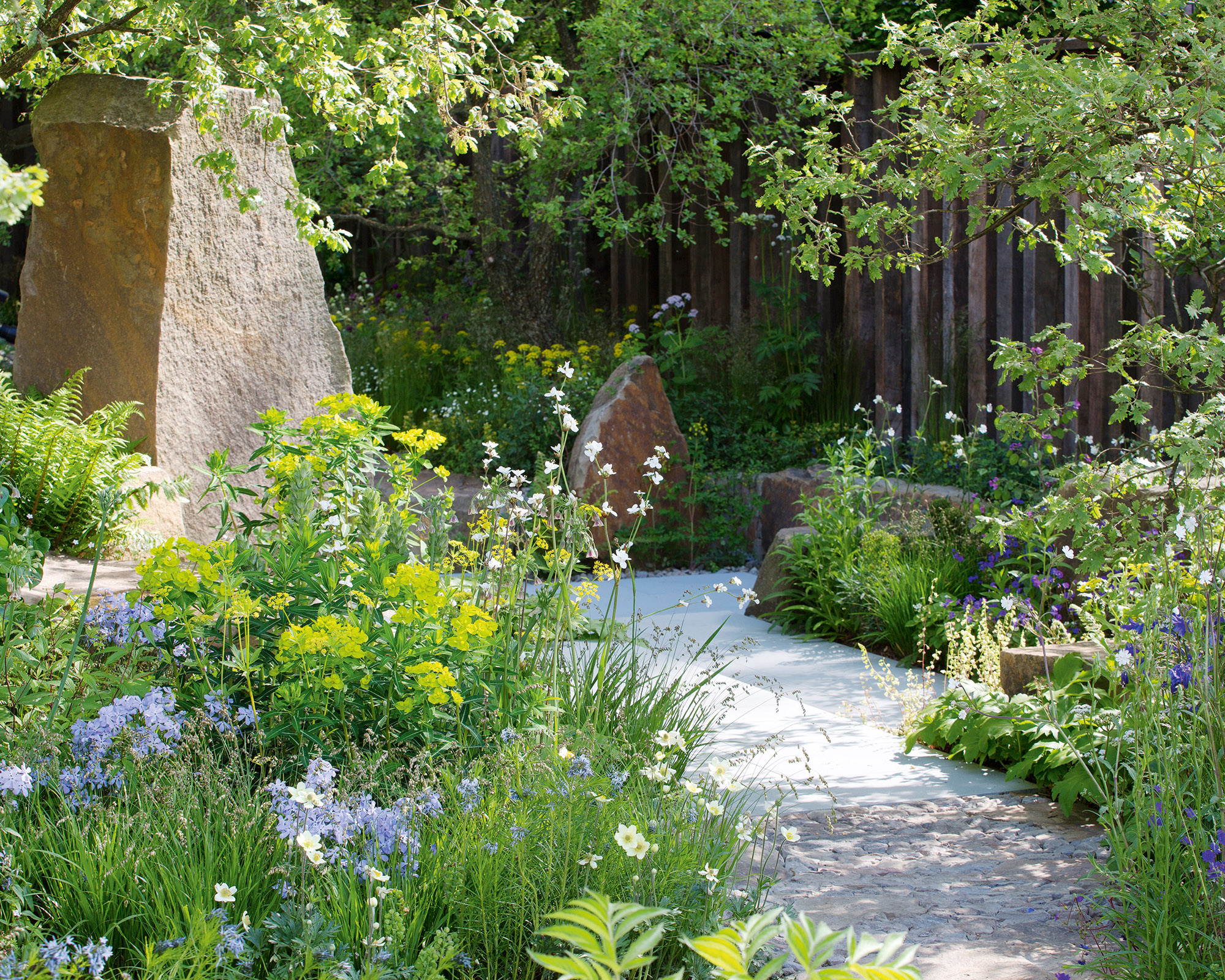
Emulating landscapes found in nature has become a theme in recent years, as here with Cleve West’s RHS Chelsea Flower Show garden design in 2016
Use local rocks in a mix of sizes to create a natural look. 'Sandstone is widely available, not protected like limestone nor too hard like granite,' says Ruth Hayes of Amateur Gardening. 'Even a small rocky area can offer diversity – a well-placed rock offers perfect conditions for sun-loving plants on one side, and shade-tolerant varieties on the other.'
Garden designer Kristina Clode believes a range of sizes should be used when creating modern rock garden ideas: 'Try to use some big rocks in the design – the bigger the better. Use a range of sizes to create a natural looking outcrop and place a few clusters of rocks here and there in nearby planting to continue the theme through the garden.'
What are the best materials for a modern rockery?
'Sustainably sourced large rocks, paddle stones and gravel are a great choice for most rock gardens,' says Angela Slater, gardening expert at Hayes Garden World.
'Limestone has been used extensively in the past which has led to large areas of degraded environmentally sensitive areas in the natural world, so always use a reputable supplier who doesn’t offer limestone.
'Paths are best constructed from large flat stones rather than paddle stones or gravel as there is less likelihood of trips and slips.'
For smaller rock gardens, stone troughs can be used to create mini rockeries. Use gravel as a mulch and smaller stones interspersed with alpine plants.
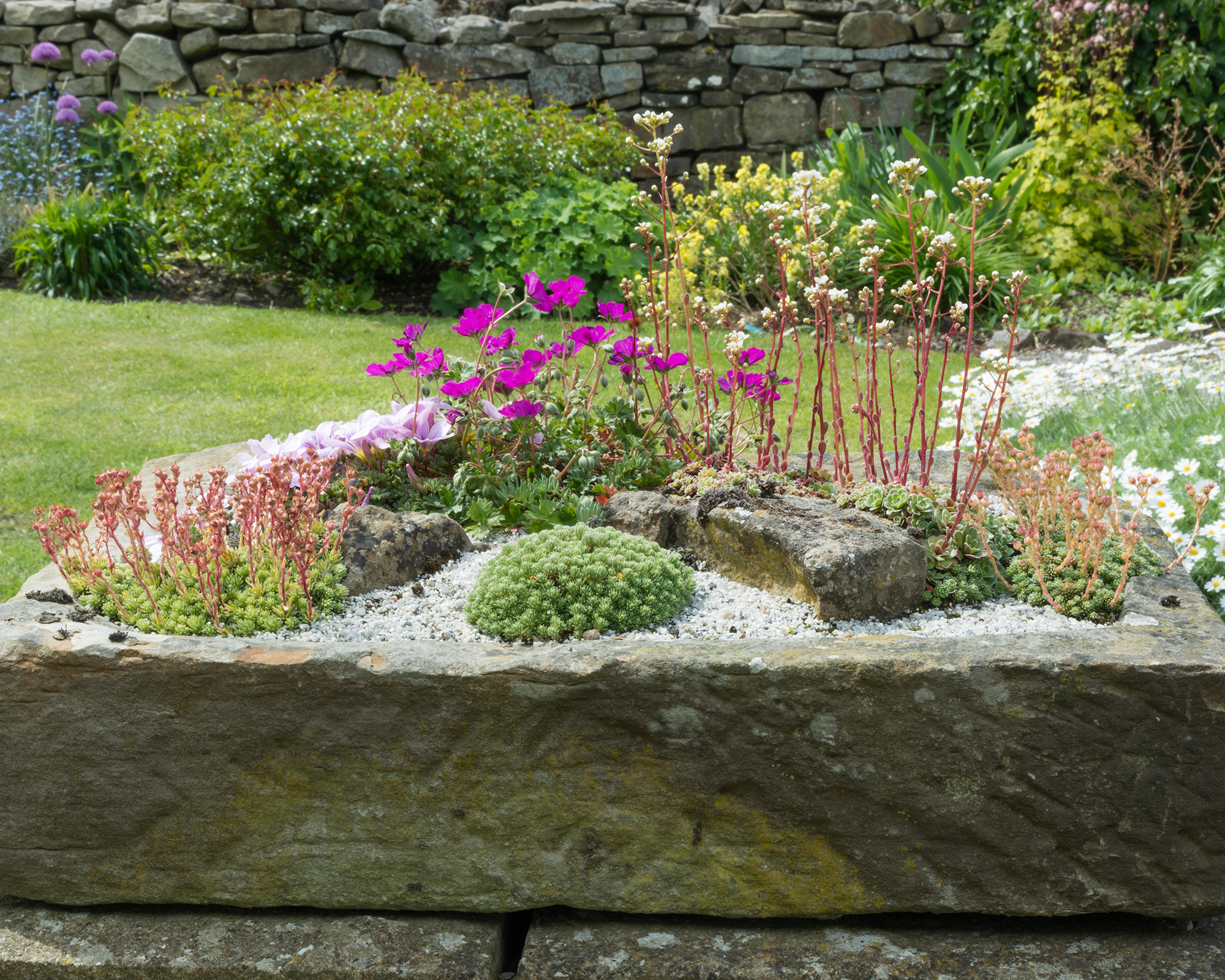
Miniature rockeries can be created in containers which are perfect for small gardens
How easy is it to maintain a modern rockery?
The amount of care required to maintain your modern rock garden ideas depends upon the type of plants you go for. Drought-tolerant perennials and grasses require very little care. However if you have any trees in your scheme you will have to clear away fallen leaves in autumn.
'Water features may need scrubbing out in spring to remove any algal growth and if the water is moving the pump will need some protection over winter,' advises Angela Slater. 'Paths also need to be kept free from algae and moss, so will need a scrub every spring.'
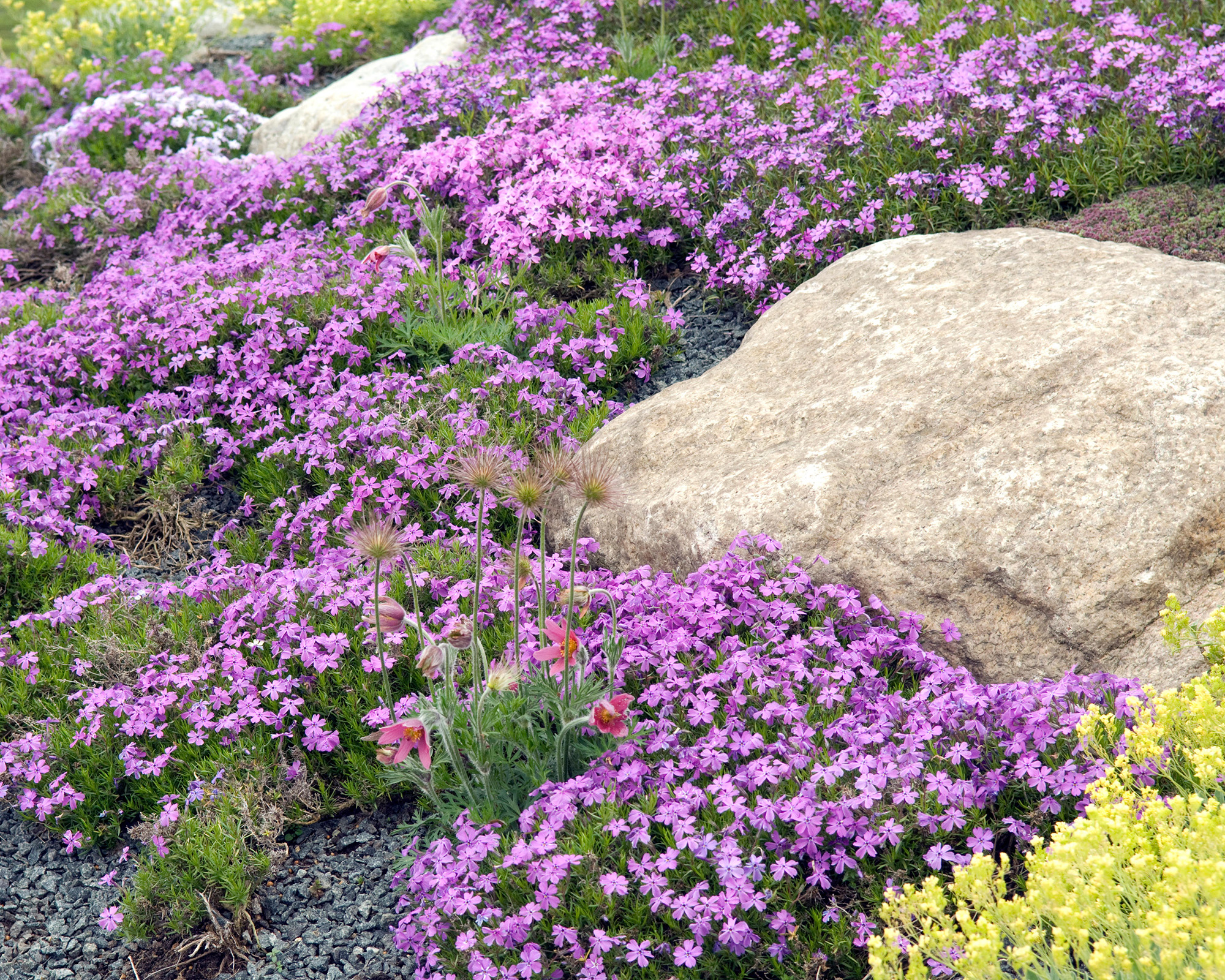
Creeping moss phlox will spread to cover your rock garden with a carpet of color
What plants should I use in a modern rock garden?
For most people the whole point of having a rock garden is the ease of maintenance, so choosing your plants needs to reflect this.
Gardening expert Angela Slater advises: 'The Mediterranean plants like Helichrysum italicum (Curry plant), Brachyglottis ‘Sunshine’ and rosemary are all drought tolerant and as such require practically no maintenance. Bearded iris love their tubers to be baked so are ideal for a hot, well-drained rock garden and can also add a sculptural element.
Adding one or two of the best trees for small gardens, such as acers, ornamental rowans and crab apples, will also help to break up the hardness of the rocky landscape.

Teresa has worked as an Editor on a number of gardening magazines for three years now. So she is lucky enough to see and write about gardening across all sizes, budgets and abilities. She recently moved into her first home and the garden is a real project! Currently she is relishing planning her own design and planting schemes. What she is most passionate about when it comes to gardening are the positive effects it has on our mental health to grow and care for plants, as well as being great for the environment too and help provide food and shelter for wildlife.
